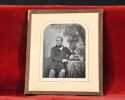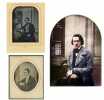BISSON Louis-Auguste (1814-1876)
Daguerréotype
L.A. Bisson Fils, Rue St. Germain l'Auxerrais 65, Prés le Pont à Paris’. 1843 Daguerréotype dans son encadrement d’origine, sous passe partout rectangulaire monogrammé en à froid « L.A.B » dans un cartouche. Très beau daguerréotype représentant un homme accoudé, le visage tourné vers la gauche, les mèches de cheveux rabattues sur les tempes , une fleur à la boutonnière, empruntée au pot de fleur posé sur la table. L’expression volontaire du sujet est particulièrement bien servie par un tirage de grande qualité. Le décor peint en arrière plan ainsi que la table, les trois livres sur lesquels repose la main gauche du personnage, se retrouvent dans plusieurs portraits de Louis Auguste Bisson, réalisés entre 1842 et 1843.
Reference : 2973
Louis Auguste Bisson est l’un des pionniers du daguerréotype en France, formé probablement auprès de Daguerre lui même. Il ouvre très tôt son premier atelier sans doute dès l’année 1840 : L.A. Bisson Fils/ Rue St. Germain l'Auxerrais 65/ Prés le Pont à Paris’.Le portrait qu’il fait d’Honoré de Balzac a été réalisé en 1842, Bisson n’utilisait encore alors de fond peint décoré. Début 1843 un fond peint à motif de feuillages et d’une vasque fleurie apparaît à l’arrière de ses portraits. Dans ces œuvres on observe les trois mêmes livres disposés de la même manière sur une nappe à motifs floraux. Le Rijksmuseum possède un daguerréotype absolument semblable au notre, avec les deux mêmes livres posés en aplat, plus un troisième, portant au dos la date de 1843. Date confirmée par un portrait de petite fille passé en vente chez Sotheby’s avec la même disposition daté également de 1843. Un détail intéressant permet de déterminer plus précisément la réalisation de ce daguerréotype : il s’agit d’un pot de fleurs que l’on retrouve dans le portrait de Celina Mickiewicz (femme d’Adam Mickiewicz). Les fleurs des deux clichés nous permettent en effet de préciser que les deux prises de vues ont eu lieu à une quinzaine de jours maximum d’intervalle dans l’année 1843, sans doute au printemps période de floraison de ces fleurs . À partir de 1844 jusqu’à la fin de son activité L. A. Bisson utilise un décor peint d’une autre nature : une bibliothèque avec des moulures. Ce second décor apparaît par exemple dans le portrait de Frédéric Chopin et d’autres daguerréotypes réalisés de 1844 à 1849, date à laquelle L.A. Bisson abandonne la technique du daguerréotype pour se consacrer à la photographie. (voir les photographies en lien avec l'article)Les daguerréotype des premières années de Louis Auguste Bisson sont d’une grande rareté.
Bookseller's contact details
L'Oeil de Mercure
M. Bernard Le Borgne
9, rue Maître Albert
75005 Paris
France
01 43 54 48 77
Payment mode

Sale conditions
Tous nos ouvrages sont garantis collationnés complets, sauf mention contraire. Tous les documents présentés sont des originaux. En tant qu'expert agréé du CNES (Chambre Nationale des Experts Spécialisés), nous garantissons l'authenticité de tous les documents présentés.
5 book(s) with the same title
"ARAGO, FRANCOIS - LOUIS DAGUERRE. - THE INVENTION OF THE DAGUERREOTYPE.
Reference : 46845
(1839)
Fixation des images qui se forment au foyer d'une chambre obscure. (Seance du Lundi 7 Janvier 1839). (+) Le Daguerréotype. (Seance du Lundi 19 Aout 1839).
Paris, Bachelier, 1839. 4to. No wrappers. In: ""Comptes Rendus Hebdomadaires des Séances de L'Academie des Sciences"", Tome VIII (No.1)+ IX, (No. 8) Entire issues offered with htitles and titlepages to both volumes. Pp. 1-36 + Pp. 249-282 and 1 lithographed plate. The papers: pp. 4-7 and pp. 250-267. A faint stamp to top of titlepages. A few brownspots to titlepages.
First Edition of the official and complete report of the invention of the ""daguerreotype"", the photographic process invented by Louis Daguerre. Together with the preliminary report of the invention (OF JANUARY 7). The presentation by Arago preceeded Daguerre's own publication ""Historique de description des procédés du daguerreotype et du diorama"", (1839). ""When the attempt to exploit the process of daguerreotype was unsuccessfull, Daguerre and Nièpce decided to offer their method to the government. Daguerre approached Francois Jean Arago, to whom he imparted, under the seal of secrecy his processes and those of Nicéphore Niépce. It was fortunate that Arago possessed such a great insight into the invention, which he received enthusiastically. He reported the invention of the daguerretype to the Academy of Sciences on January 7, 1839. The secrecy, however, was not observed very carefully, for the ""Gazette de France"" published a note abouit it on January 6, 1839, although without printing any details.""(Eder ""History of Photography"").
Le Daguerréotype. (Seance du Lundi 19 Aout 1839). (+ Daguerre:) Des procédés photogéniques comme moyens de gravure - Lettre de M. Daguerre à M. Arago. (Séance du Lundi 20 Septembre 1839).
(Paris, Bachelier), 1839. 4to. No wrappers. In: ""Comptes Rendus Hebdomadaires des Séances de L'Academie des Sciences"", Tome IX, No. 8 a. 14. Pp. (249-) 282 a. pp. (417-) 436. Arago's rapport: Pp. 250-267 - Daguerre's letter: pp. 423-429. Both issues clean and fine.
First printing of the first official and complete report of the invention of the ""daguerreotype"", the photographic process invented by Louis Daguerre. The presentation by Arago preceeded Daguerre's own publication ""Historique de description des procédés du daguerreotype et du diorama"", (1839). Together with Daguerre's letter to Arago in which he relates the process of heliography and describes his contract with Niépce to exploit the heliogrphis process. The Heliogravure was invented by Niépce
L’Artiste, journal de la litterature et des beaux arts : LE DAGUEROTYPE DAGUERREOTYPE
Journal de la littérature et des beaux-arts, 2e série, tome 2. Paris, 1839,2eme SÉRIE, TOME 2, 1839,nov. 1838 - avr. 1839. Paris: Bureaux de l’Artiste, 1839. First edition. 4to.contient Jules Janin, « Le Daguerotype »p 145 à 148,Georges Sand le dernier sauvage roman, etc,texte à 2 colonnes .IN FOLIO demi basane à coins,dos lisse romantique orné,tranches marbrées,366p.,33 lithographies et eaux fortes ht reliées in fine avec rousseurs,texte frais ,rare complet.
Jules Gabriel Janin (1804 - 1874) a French writer and critic, published a series of reviews of the newly announced daguerreian process in L’ARTISTE p116 Daguère. Apparently, having attended Arago’s official announcement of the process on 19 August, Janin and others were left confused at the complexity of the daguerreian process. Having read Janin’s critique in the August 25 issue of L’ARTISTE, Daguerre called upon him to witness a demonstration of the process at his studio; at this point, only a very few had had such an opportunity. Daguerre started with polishing the plate and moved through all the steps to prepare for the exposure. The camera had been readied and focused on a view out of the window. After a six minute exposure, the plate was “developed” under the mercury vapors, fixed and washed. Upon viewing the finished plate, Janin commented, “The view looks as if it had been drawn by the hand of the fairy queen Mab.” Janin expressed his regret that Daguerre had not demonstrated his procedureon 19 August, for it would have shown that it was not too complicated, as Arago had made it appear. This review in the 1 September 1839 issue of L’ARTISTE recounts the demonstration. Also see: Gernsheim,Helmut. L.J.M. DAGUERRE: THE HISTORY OF THE DIORAMA AND THE DAGUERREOTYPE, p. 102 - 103.Premier article paru sur l'invention du "Daguerréotype" extrait de la revue "L'Artiste" en 1839. Daguerre découvre ce procédé en 1835. Après des années de perfectionnement, il présente sa découverte à l'Académie des Sciences le 9 janvier 1839. Le brevet de Daguerre est acquis par le gouvernement français, ce qui permet à l'Académie, en publiant les détails du procédé le 19 août 1839, d'en doter libéralement le monde entier. Remise de 20% pour toutes commandes égales ou supérieures à 100 €
Reference : 1643
Daguerréotype (circa 1845)
Daguerréotype demi-plaque, à vue 14 x 11 cm, dans un bel encadrement d'origine, verre d'origine ; rehaussé en couleur.Représentant un père et sa fille, une mention manuscrite au dos nous donne l'identité des personnes représentées : "Monsieur Louis Vérité et Mlle Louise Vérité mariée à M. Jules Jouet". Un daguerréotype surprenant de vie, centré sur le visage de cette petite fille au regard sombre, presque inquiétant, qui donne à l'image comme une touche surnaturelle.
"DRAPER, (JOHN) WILLIAM. - THE FIRST DAGUERREOTYPE PORTRAIT.
Reference : 46912
(1840)
On the Process of Daguerreotype, and its application to taking Portraits from the Life.
London, Richard and John Taylor, 1840. Contemp. hcalf. A nic to spine at upper hinge. Hinges weakening (not loose). Gilt lettering to spine ""Philosophical Magazine"" - Vol.XVII. In: ""The London, Edinburgh, and Dublin Philosophical Magazine and Journal of Science. Conducted by David Brewster et al."". Vol. XVII. A stamp to titlepage and a few other pages. Entire volume offered. VIII,552 pp. Draper'spaper: pp. 217-225.
First printing of the famous paper in which Draper relates how he was able to made the first photographic portrait on a daguerreotype plate, giving an ennormously long exposure. The subject of the portrait, Draper's assistant, powdered his face with flour and sat in front of the camera for a half hour facing the sunlight.Draper stated that it is possible to make portraits in full sunlight, using mirrors as light reflectors. ""But in the reflected sunshine, the eye cannot support the effulgence of the rays. It is therefore necessary to pass them through some blue medium, which shall abstract from them their heat and take away their offensive brilliancy. Ihave used for this purpose blue glass, and also ammoniaco-sulphate of copper, contained in a large trough of plate glass, the interstice being about an inch thick."" (p. 217 in the paper offerd).""Draper first achieved wide celebrity for his pioneering work in photography. As early as 1837, while still in Virginia, he had followed the example of Wedgwood and Davy in making temporary copies of objects by the action of light on sensitized surfaces. When the details of Daguerre’s process for fixing camera images were published in various New York newspapers on 20 September 1839, Draper was ready for the greatest remaining challenge, to take a photographic portrait. A New York mechanic, Alexander S. Wolcott, apparently won the race by 7 October. But if Draper knew of this, he persisted in his own experiments and succeeded in taking a portrait not later than December 1839. His communication to the Philosophical Magazine, dated 31 March 1840, was the first report received in Europe of any photographer’s success in portraiture. The superb likeness of his sister Dorothy Catharine, taken not later than July 1840, with an exposure of sixty-five seconds, seems to be the oldest surviving photographic portrait.""(DSB).The volume contains also Michael Faraday's importent letter to Gay-Lussac on induction in the first English version. ""On Magneto-electric induction."", pp. 281-89 a. pp.356-366. (Originally published in French in ""Annales de Chimie et Physique"" in 1832.
 Write to the booksellers
Write to the booksellers







